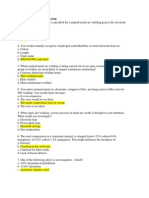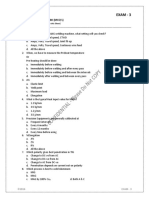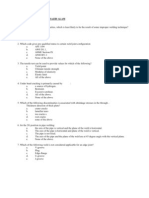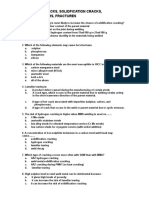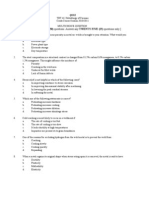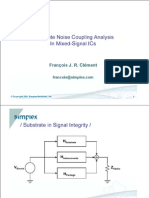Welding Inspection, Steels Multi - Choice Question Paper (MFY-007)
Welding Inspection, Steels Multi - Choice Question Paper (MFY-007)
Uploaded by
Moses_JakkalaCopyright:
Available Formats
Welding Inspection, Steels Multi - Choice Question Paper (MFY-007)
Welding Inspection, Steels Multi - Choice Question Paper (MFY-007)
Uploaded by
Moses_JakkalaOriginal Description:
Original Title
Copyright
Available Formats
Share this document
Did you find this document useful?
Is this content inappropriate?
Copyright:
Available Formats
Welding Inspection, Steels Multi - Choice Question Paper (MFY-007)
Welding Inspection, Steels Multi - Choice Question Paper (MFY-007)
Uploaded by
Moses_JakkalaCopyright:
Available Formats
TWI THE WELDING INSTITUTE
Welding Inspection, Steels
Multi - Choice Question Paper (MFY-007)
1. Chromium molybdenum steels for high temperature service typically have their
carbon content below 0.2% What other element is added to the steel to create a stable
steel at elevated temperatures?
a. Vanadium
b. Selenium
c. Sulphur
d. Nickel
2. Which of the following could be used to prevent intercrystal line corrosion in
Austenitic Stainless steel?
a. Vanadium
b. Selenium
c. Sulphur
d. Niobium
3. Which of the following metals is most easily to be welded?
a. High strength steel
b. Stainless steel
c. Medium carbon steel
d. Mild steel
Multi - Choice Question Paper (MFY-007)
TWI THE WELDING INSTITUTE
4. Hydrogen trapped in the weldment can cause hydrogen cracking if the content of
hydrogen is too high. What is the other name commonly used to describe hydrogen
cracking?
a. Hot tears
b. Liquation cracking
c. Reheat cracking
d. Delay cracking
5. Which of the following is not a pattern that the atoms of steel arrange themselves in?
a. Body centered cubic
b. Body centered tetragonal
c. Face centered cubic
d. Diamond centered cubic
6. A hard and brittle microstructure in low alloy steel can be improve its properties to
soft and ductile by:
a. Increasing the heat input during welding
b. Must follow by post heating after welding
c. Hardening
d. Annealing
7. What happen to the properties of the steel when the carbon is increased to 0.6%?
a. Ductility increases
b. Weld ability increases
c. Malleability in increases
d. Tensile strength increases
Multi - Choice Question Paper (MFY-007)
TWI THE WELDING INSTITUTE
8. What is the affect will occur to carbon manganese steel if the steel has been rapid
cooled from austenite region?
a. It becomes ductile
b. The toughness increases
c. Its hardness increases
d. Its yield strength decreases
9. Which of the following statements is true with regards to hydrogen cracking?
a. It is because of rapid cooling of weld metal and others factor
b. It is a hot type of crack
c. It only occur in the HAZ
d. Ductile grain structure is the most susceptible to hydrogen cracking
10. The arc energy during a welding process:
a. Does not effect the toughness of weldment
b. Must be high in order to avoid lack of fusion
c. Affects the width of HAZ
d. All of the above
11. In a martensitic grain structure what would you not expect to increase?
a. Strength
b. Hardness
c. Toughness
d. All of the above
12. Nitrogen and oxygen are considered to be important elements during the steel making
process:
a. Cause sulphur to isolate in the steel
b. Cause imperfections if not removed in sufficient quantities
c. Improve the quality of steel
d. Improve the surface appearance of the steel
Multi - Choice Question Paper (MFY-007)
TWI THE WELDING INSTITUTE
13. Sulphur is added to steel to improve:
a. Strength
b. Hardness
c. Toughness
d. Machine characteristic of the steel
14. Oxygen and sulphur in steels for a non-metallic inclusion during the rolling process
and can lead to what after welding:
a. Sulphide precipitation
b. Oxygen rich welds
c. Lamellar tearing
d. Stress corrosion
15. Steel is an alloy composed mainly of
a. Coke and iron
b. Magnesium and copper
c. Carbon and chromium
d. Iron and carbon
16. When weave technique the heat input using the same welding parameters (amps and
voltage), as those used for stringer bead will be:
a. Be the same as that for the stringer bead
b. Lower than that for the stringer bead
c. Will be higher than the stringer bead
d. Unaffected because technique has no influence on the heat input
17. Heat treating will:
a. Improve the yield strength of the steel only
b. Increase the elongation of the steel only
c. Alter the chemical composition of the steel
d. Not improve the properties of steel as a whole
Multi - Choice Question Paper (MFY-007)
TWI THE WELDING INSTITUTE
18. The region of HAZ that gets heated to a temperature between 700 c and 900 c is
called:
a. Wide band HAZ
b. Tempered HAZ
c. Spherodised HAZ
d. Intercritical HAZ
19. The fully transformed HAZ located next to the fusion boundary in a weldment is the
area:
a. Where cracking does not occur
b. Where cold cracks will not occur
c. With lowest tendency to form cold cracks
d. With the highest tendency to cold cracks
20. Martensite is a hard phase in steel and highly dependent on its properties from the
amount of carbon trapped in the Body Centered Cubic atom arrangement. When
carbon is trapped in this atom arrangement to cause the:
a. Carbon dissolves in this iron
b. Carbon atoms cause the BCC shape to distort resulting in increased hardness
c. Iron transforms to pig iron
d. Carbon separates out to form isolated island martensite
21. Slowly cooled of mild carbon steels have a microstructure with:
a. High tensile strength
b. Lowest strength and the highest ductility
c. Highest strength with lowest toughness
d. Brittle structure
Multi - Choice Question Paper (MFY-007)
TWI THE WELDING INSTITUTE
22. The ability of the alloy steel to form martensite can be determined by its ;
a. Iron carbon diagram
b. Equilibrium diagram
c. Carbon equivalent value
d. Transition curve diagram
23. The formation of hard and brittle grain structure in alloy steel can be controlled by:
a. Used of low arc energy
b. Increase the material thickness
c. Pre heating the material to welding
d. All of the above
24. The cooling rates of weldment is very critical where it can gives a formation of
martensite or Bainite. What factors that will influence the cooling rates?
a. Type of consumables and materials
b. Size of electrodes and welding position
c. Thickness, material size and thermal conductivity
d. All of the above
25. The main factors likely to cause lamellar tearing are thus:
a. Materials with lamination
b. Materials with greater thickness
c. Materials with high thermal conductivity
d. Low, short transverse ductility materials
26. The combination of iron and sulphur during welding will promotes:
a. Globular form of microstructure along the grain boundaries
b. Higher strength of the center of weld metal
c. Low melting point along the grain boundaries
d. Higher hardness of weld metal compared to HAZ
Multi - Choice Question Paper (MFY-007)
TWI THE WELDING INSTITUTE
27. The purpose of through thickness test is to determine:
a. The susceptibility of materials to hot cracking
b. The strength of through thickness of materials
c. The amount of energy absorb and toughness of materials
d. Susceptibility of steel plate to lamellar tearing
28. Which following factor does not contribute to the formation of solidification
cracking?
a. High dilution welding process
b. Low travel speed applied during welding
c. High sulphur materials
d. Fast travel speed
29. Which of the following statement is correct, for multi run welding compare to single
passed welding:
a. High productivity can be produced with multi run
b. Higher distortion with multi run compare to single run
c. Higher energy absorbed and higher toughness with multi run
d. Multi run welding less cracking to occur
30. What alloying element that may helps on controlling of intercrystaline corrosion in
austenitic stainless steel
a. Molybdenum
b. Vanadium
c. Columbium (Niobium)
d. Cooper
Multi - Choice Question Paper (MFY-007)
You might also like
- CSWIP 3.1 Question and AnswerDocument31 pagesCSWIP 3.1 Question and AnswerDevendran Marappan92% (59)
- Multi Choice Tech 1 AnswerDocument20 pagesMulti Choice Tech 1 Answerquyennq100% (2)
- Question On CSWIP 3.2Document7 pagesQuestion On CSWIP 3.2mushruff89% (9)
- Cswip 3.2 MCQ-004Document5 pagesCswip 3.2 MCQ-004Moses_Jakkala71% (7)
- Cswip 3.2 MCQ-004Document5 pagesCswip 3.2 MCQ-004Moses_Jakkala71% (7)
- Welding Inspection Level 2 - Paper 5 Technology - Exercise IVDocument10 pagesWelding Inspection Level 2 - Paper 5 Technology - Exercise IVMohd Farid Osman100% (2)
- Welding Questions PDFDocument42 pagesWelding Questions PDFA. ΒρατσισταNo ratings yet
- Welding Inspector ExamDocument7 pagesWelding Inspector ExamEhab Ahmed100% (1)
- Cswip 2015 Q& ADocument61 pagesCswip 2015 Q& ANaga Jothi50% (2)
- ME 2204 Fluid Mechanics and Machinery TEST (I Unit) KeyDocument12 pagesME 2204 Fluid Mechanics and Machinery TEST (I Unit) KeyVignesh Vicky80% (5)
- B. The Amount of Time The Electrode Is Being UsedDocument4 pagesB. The Amount of Time The Electrode Is Being UsedSolomon AttaNo ratings yet
- Cswip Paper 3.1Document5 pagesCswip Paper 3.1Fran Bakkara100% (1)
- Cswip 3.2 MCQ-001Document5 pagesCswip 3.2 MCQ-001Moses_JakkalaNo ratings yet
- Multiple Choice 2 Heat Treatment Carbon Content PreheatDocument10 pagesMultiple Choice 2 Heat Treatment Carbon Content PreheatAhmed Ben Nouma100% (1)
- General 3Document5 pagesGeneral 3AnandNo ratings yet
- CSWIP Test No 2Document3 pagesCSWIP Test No 2stanley100% (2)
- Cswip 3.1 Difficul - Multichoice QuesDocument11 pagesCswip 3.1 Difficul - Multichoice QuesLuan Nguyen0% (1)
- CSWIP Sample QuestionsDocument31 pagesCSWIP Sample QuestionsNeo80% (5)
- Cswip QA/answerDocument6 pagesCswip QA/answerJoseph PeterNo ratings yet
- Cswip 3.2 Q&aDocument3 pagesCswip 3.2 Q&aMoses_Jakkala100% (5)
- M CHOICE in Ra Để Mang Ve NhaDocument102 pagesM CHOICE in Ra Để Mang Ve NhaDinh Quang NhamNo ratings yet
- Paper 1Document6 pagesPaper 1Umaibalan100% (1)
- WISS CSWIP Technology Multiple Choice Exam 1 Version A 18 August 2014Document10 pagesWISS CSWIP Technology Multiple Choice Exam 1 Version A 18 August 2014rinhycraNo ratings yet
- Technology 1Document9 pagesTechnology 1Prabhu KalpakkamNo ratings yet
- Cswip-Reviewer - DAY 3 HOME WORKDocument43 pagesCswip-Reviewer - DAY 3 HOME WORKshrikantajit100% (1)
- Paper 3Document10 pagesPaper 3Umaibalan100% (2)
- Technology Multiple Choice 3Document10 pagesTechnology Multiple Choice 3Alex KullehNo ratings yet
- Wa0082 PDFDocument34 pagesWa0082 PDFmiteshNo ratings yet
- Technology Multiple Choice Exam Få Fò - HWPDocument39 pagesTechnology Multiple Choice Exam Få Fò - HWPMark Darrel Aranas100% (3)
- General 2Document4 pagesGeneral 2Sobia KalsoomNo ratings yet
- TECHNOLOGY1 Answer-1Document6 pagesTECHNOLOGY1 Answer-1JlkKumarNo ratings yet
- CSWIP 3.1 Training Questions For Pipe Butt Weld 3Document5 pagesCSWIP 3.1 Training Questions For Pipe Butt Weld 3ahmad fikrieNo ratings yet
- Chapter-17 Weldability ....Document6 pagesChapter-17 Weldability ....shahid khanNo ratings yet
- CSWIP 3.1 (SET-3) : Exam - 3Document11 pagesCSWIP 3.1 (SET-3) : Exam - 3JAGADEESH NAIK100% (2)
- TECHNOLOGY3 AnswerDocument7 pagesTECHNOLOGY3 Answerابومحمد الكنانيNo ratings yet
- CSWIP 3.1 (Updates-2016) : General - 1Document9 pagesCSWIP 3.1 (Updates-2016) : General - 1Pradeep0% (1)
- ''Technology Examination Questions (Multi-Cohice Exam - 1)Document4 pages''Technology Examination Questions (Multi-Cohice Exam - 1)Vijaya BaraniNo ratings yet
- Cswip QuestioDocument15 pagesCswip Questioniminkp123100% (1)
- 4 - 0 MC Destructive TestingDocument23 pages4 - 0 MC Destructive TestingRidho Kurniawan100% (1)
- Exam - 3Document11 pagesExam - 3Stanley Alex100% (1)
- Wis 5 Eoca AnswersDocument34 pagesWis 5 Eoca AnswersAli Clubist100% (1)
- Test 7Document6 pagesTest 7mishicox100% (2)
- Model Question PaperDocument48 pagesModel Question Paperselva100% (2)
- Multi - Choice Question Paper (MSR-WI-1)Document8 pagesMulti - Choice Question Paper (MSR-WI-1)Karit Hawichit100% (1)
- Cswip Questions and AnswerDocument4 pagesCswip Questions and Answerenels770% (2)
- Sample Questions On CSWIP 3.1Document16 pagesSample Questions On CSWIP 3.1mushruff100% (3)
- Cswip3.1 Exam QuestionDocument4 pagesCswip3.1 Exam QuestionMOHAMMAD SAJIDALAM100% (2)
- Cswip3.1 QuestionsDocument127 pagesCswip3.1 Questionsshafisham4u50% (2)
- Cswip Questions and AnswersDocument8 pagesCswip Questions and AnswersTariq Hussain100% (2)
- MFY 007 Issue 2Document6 pagesMFY 007 Issue 2baihaqiasidiqi26No ratings yet
- Weld Ability of SteelsDocument17 pagesWeld Ability of Steelsdineshkumarse019No ratings yet
- Welding Quiz 1Document14 pagesWelding Quiz 1RakeshNo ratings yet
- Wa0084Document33 pagesWa0084miteshNo ratings yet
- 17.weldability - McqsDocument5 pages17.weldability - McqsJawed AkhterNo ratings yet
- Cswip QbankDocument23 pagesCswip QbankFownoon100% (1)
- What Is WeldingDocument4 pagesWhat Is WeldingAnonymous hBBam1nNo ratings yet
- Mfy 003Document4 pagesMfy 003Le TuanNo ratings yet
- Paper 1Document5 pagesPaper 1andika eka putraNo ratings yet
- Cswip QuestionsDocument31 pagesCswip Questionsanandu vjNo ratings yet
- Multichoice Paper OneDocument4 pagesMultichoice Paper OneAhmed ShakirNo ratings yet
- CHAPTER-20 Heat Treatment...Document11 pagesCHAPTER-20 Heat Treatment...shahid khanNo ratings yet
- TBT 412Document7 pagesTBT 412Mugesh RanjanendranNo ratings yet
- CSWIP Test No 2Document3 pagesCSWIP Test No 2stanley100% (2)
- Edible CutleryDocument4 pagesEdible CutleryMoses_JakkalaNo ratings yet
- Welding Inspection: Multi-Choice Questions Paper 1 Please Return This Paper UnmarkedDocument4 pagesWelding Inspection: Multi-Choice Questions Paper 1 Please Return This Paper UnmarkedSurendra KamalNo ratings yet
- Master Answers For Paper 1-4 Rev 2Document4 pagesMaster Answers For Paper 1-4 Rev 2Moses_JakkalaNo ratings yet
- Test No 3Document3 pagesTest No 3stanleyNo ratings yet
- 3DprintingV9 2Document64 pages3DprintingV9 2Moses_JakkalaNo ratings yet
- Cswip 3.2 Q&aDocument3 pagesCswip 3.2 Q&aMoses_Jakkala100% (5)
- Application - Cum - Declaration As To The Physical FitnessDocument2 pagesApplication - Cum - Declaration As To The Physical FitnessMoses_JakkalaNo ratings yet
- Master Answers 3.2 Senior Weld InspectorDocument1 pageMaster Answers 3.2 Senior Weld InspectorMoses_JakkalaNo ratings yet
- Cswip 3.2 Mfy-005Document6 pagesCswip 3.2 Mfy-005Moses_Jakkala100% (2)
- Application Form For Licence To Drive A Motor VehicleDocument2 pagesApplication Form For Licence To Drive A Motor VehicleMoses_JakkalaNo ratings yet
- CSWIP 3.2 Answer For Msr-Wi-1 To 4Document1 pageCSWIP 3.2 Answer For Msr-Wi-1 To 4Moses_JakkalaNo ratings yet
- AWS - CWE Registration FormDocument2 pagesAWS - CWE Registration FormMoses_JakkalaNo ratings yet
- Freecorp InstallationDocument4 pagesFreecorp Installationreza329329No ratings yet
- HVAC Duct Round CatalogDocument12 pagesHVAC Duct Round CatalogMoses_JakkalaNo ratings yet
- Data Entry Jobs OverviewDocument1 pageData Entry Jobs OverviewMoses_JakkalaNo ratings yet
- HVAC Ducting Rectangle CatalogDocument20 pagesHVAC Ducting Rectangle CatalogMoses_JakkalaNo ratings yet
- Technical Specfications For 5 Ton EOT CraneDocument10 pagesTechnical Specfications For 5 Ton EOT CraneMoses_JakkalaNo ratings yet
- Duct HVAC MachineDocument6 pagesDuct HVAC MachineMoses_Jakkala0% (1)
- Israel Bible MapDocument1 pageIsrael Bible MapMoses_JakkalaNo ratings yet
- Aradana Holy Land TourDocument1 pageAradana Holy Land TourMoses_JakkalaNo ratings yet
- Inconel 625 Welding MetallurgyDocument8 pagesInconel 625 Welding MetallurgyMoses_Jakkala100% (1)
- Surfacing of 3.25% Nickel Steel With Inconel 625 by The Gas Metal Arc Welding-Pulsed Arc ProcessDocument8 pagesSurfacing of 3.25% Nickel Steel With Inconel 625 by The Gas Metal Arc Welding-Pulsed Arc ProcessMoses_JakkalaNo ratings yet
- The Link Between Vitamin B12 and Methylmercury - A ReviewDocument5 pagesThe Link Between Vitamin B12 and Methylmercury - A ReviewOstensibleNo ratings yet
- Exercise 6 ElectrowinningDocument2 pagesExercise 6 Electrowinningहरिओम हरी100% (5)
- Chem ProposalDocument3 pagesChem ProposalKlarize Faye ChanNo ratings yet
- New Reference Equation of State For Associating LiquidsDocument13 pagesNew Reference Equation of State For Associating LiquidsDiego Hernández PastorNo ratings yet
- Gaussian ThermochemistryDocument19 pagesGaussian ThermochemistryMoslem DaneshNo ratings yet
- Chapter 3 FormworkDocument11 pagesChapter 3 FormworkSue IlaNo ratings yet
- SDS-Uranium Oxide UO2Document11 pagesSDS-Uranium Oxide UO2Anonymous mZEUquNo ratings yet
- Use in The Following: How To Calibrate Using Standard Solution How To MeasureDocument2 pagesUse in The Following: How To Calibrate Using Standard Solution How To MeasureStephen LeighNo ratings yet
- Performance Prediction of Axial Flow Compressors Using Stage Characteristics PDFDocument10 pagesPerformance Prediction of Axial Flow Compressors Using Stage Characteristics PDFgready64100% (1)
- Mathematical StudiesDocument56 pagesMathematical StudiesOayes MiddaNo ratings yet
- Frequently Asked Questions: Pectin Assay Using M-HydroxydiphenylDocument2 pagesFrequently Asked Questions: Pectin Assay Using M-HydroxydiphenylRodrigosqmNo ratings yet
- Amine Best Practices GuideDocument63 pagesAmine Best Practices GuideJerold100% (3)
- Flat Spots Bright Spots 01Document1 pageFlat Spots Bright Spots 01Mazhar BadrNo ratings yet
- GLXXUnirex N SeriesDocument3 pagesGLXXUnirex N SeriesvamsiklNo ratings yet
- Makaut University Sem07Document4 pagesMakaut University Sem07Sourav PandaNo ratings yet
- 20.B.V.R. Chowdari PDFDocument11 pages20.B.V.R. Chowdari PDFhimamahanNo ratings yet
- 9 3 Energy Transfer in Air and in WaterDocument6 pages9 3 Energy Transfer in Air and in Waterapi-212901753No ratings yet
- L R G TreloarDocument1 pageL R G Treloarapi-3733260No ratings yet
- Hose and Fittings PDFDocument106 pagesHose and Fittings PDFchak1729No ratings yet
- Crown Ether: From Wikipedia, The Free EncyclopediaDocument3 pagesCrown Ether: From Wikipedia, The Free EncyclopediaShaikh SalmanNo ratings yet
- Topic 13 - Entoptic PhenomenaDocument4 pagesTopic 13 - Entoptic PhenomenashadowosNo ratings yet
- Properties of Steel Fibre Reinforced ConcreteDocument8 pagesProperties of Steel Fibre Reinforced ConcreteCuriosoNo ratings yet
- SOP of Sanitation of PW SystemDocument6 pagesSOP of Sanitation of PW Systemanon_350461302100% (1)
- Charrex PFP-1000Document2 pagesCharrex PFP-1000Barathan RajandranNo ratings yet
- Ethidium Bromide Decontamination MethodsDocument3 pagesEthidium Bromide Decontamination MethodsRaghavendra GunnaiahNo ratings yet
- Substrate Noise Coupling Analysis in Mixed Signal ICsDocument34 pagesSubstrate Noise Coupling Analysis in Mixed Signal ICsapi-19668941No ratings yet
- New Control Valve BrochureDocument12 pagesNew Control Valve BrochurejabalpuramitNo ratings yet
















